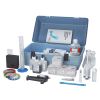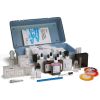Hach FF-2 Freshwater Aquaculture Test Kit
Features
- The digital titrator is a compact, accurate dispensing unit that replaces a buret
- Color disc features a continuous-gradient color wheel for fast, accurate comparisons
- All tests are stored in rugged carrying case
- Free ground shipping
- Expedited repair and warranty service
- Lifetime technical support
- More
Overview
The Hach Freshwater Aquaculture Test Kit allows the measurement of 10 critical water parameters using accurate Digital Titrator titration and continuous color-disc colorimetry.
Mechanics
Acidity, alkalinity, carbon dioxide, chloride, dissolved oxygen, and hardness tests are conducted with the Digital Titrator - a compact, accurate dispensing unit that replaces a buret. Ammonia nitrogen, nitrite nitrogen, and pH determinations are colorimetric tests. Results are obtained by matching the developed color of the sample to a precalibrated color disc. The kit also contains a rugged, armored thermometer for temperature readings.
Durable
With this aquaculture kit, the analyst can obtain the data necessary for making the right management decisions. Packaged in a durable, portable case, the kit can be used for measurements in the field.
- (2) 100mL Bottles of Deionized Water
- (23) Reagents
- (1) Flask
- (1) Graduated Cylinder
- (1) Color Comparator Box
- (1) Digital Titrator
- (1) Delivery Tube
- (2) Plastic Tubes
- (1) Thermometer
- (1) BOD Bottle
- (3) Color Discs
- (1) Manual
- (1) Carrying Case
In The News
Lake Erie Volunteer Science Network: Building Trust in Citizen Science Programs
Citizen science programs have popped up across the United States, focusing on connecting local communities with nearby water resources and building a trustworthy data pool over the sampling period. While commonly utilized as a means of ensuring that large watersheds or lake regions are adequately sampled, the credibility and success of such programs have been called into question. [caption id="attachment_38996" align="alignnone" width="940"] HRWC volunteers measure stream velocity across a subsection of Woods Creek, a tributary of the Huron River near Belleville, Michigan. Stream velocity measurements can be combined with water level measurements to calculate stream flow and chemical parameter loads.
Read MoreMonitoring Lake Erie’s Eastern Basin: Building Long-Term Data and Real-Time Public Solutions
In the eastern basin of Lake Erie, off the coast of Dunkirk, New York, a data buoy collects valuable water quality, weather, and wave data that inform residents and regulatory groups of conditions on the water. Since 2011, Buffalo State University’s Great Lakes Center has maintained and operated the Dunkirk buoy with funding from the Great Lakes Observing System (GLOS) and field support from the NYSDEC Lake Erie Fisheries Research Unit. [caption id="attachment_38976" align="aligncenter" width="940"] The Dunkirk Buoy viewed from the research vessel after being deployed in early spring.
Read MoreSonTek CastAway-CTD Meter Review
Lightweight and easy to use, the SonTek CastAway offers a convenient 3-in-1 solution for measuring conductivity, temperature, and depth profiles. At a 5 Hz sampling rate, the CastAway is designed for up to 1 m/s free-fall through the water column. With fast response and accurate conductivity, temperature, and depth measurements, the CastAway is ideal for thermocline and halocline profiling. The unit also reports salinity and speed of sound. [caption id="attachment_38732" align="alignnone" width="940"] Environmental scientist, Katelyn Kubasky, holding the SonTek CastAway in front of the pond at the Fondriest Center for Environmental Studies.
Read More








